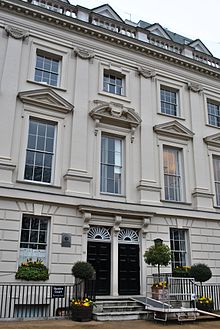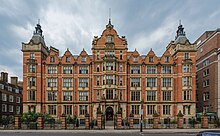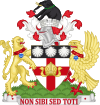Lincoln's Inn Fields
This article includes a list of general references, but it lacks sufficient corresponding inline citations. (July 2016) |
51°30′58″N 0°07′00″W / 51.5161°N 0.1166°W


Lincoln's Inn Fields is the
Lincoln's Inn Fields takes its name from the adjacent Lincoln's Inn, of which the private gardens are separated from the Fields by a perimeter wall and a large gatehouse.
The grassed area in the centre of the Fields contains a court for tennis and netball, and a bandstand. It was previously used for corporate events, which are no longer permitted. Cricket and other sports are thought to have been played here in the 18th century.
History

Lincoln's Inn was situated in the county of Middlesex. Up to the 17th century cattle were grazed upon the fields, which were part of the Holborn grassland named Pursefield and belonged to St Giles Hospital. In the report of excavations of 64 Lincoln's Inn Fields,[6] it is noted that one Katherine Smyth, the owner of the White Hart Inn on Drury Lane, leased the land from 1520. It then reverted to the Crown, and was used as pasture and occasionally for an execution.
The use of the pastures meant that
Schemes for redevelopment of the fields by Inigo Jones and Charles Cornwallis in 1613 and 1618 were unsuccessful. William Newton gained permission, however, to erect 32 houses in what became known as Lincoln's Inn Fields in 1638 for an annual fee of £5 6s 8d. However, the building licence was only given if the central area remained an outdoor space open to the public. Quarry pits were discovered in the excavations at No. 64 (see above), probably for building materials, in particular, gravel. In the fill of one was a fragment of a 'fuddling cup', a drinking vessel which made it deliberately difficult to drink from without spillage.
When originally laid out, Lincoln's Inn Fields was part of fashionable London. The completion of the houses that surrounded it proceeded at a leisurely pace, interrupted by the

Another seventeenth-century survival is now 66 Lincoln's Inn Fields, which was built for Lord Powis and known as Powis House. The charter of the Bank of England was sealed there on 27 July 1694. It was in 1705 acquired by the Duke of Newcastle (whereupon it became known as Newcastle House) who had it remodelled by Sir John Vanbrugh (following earlier work by Christopher Wren after a fire in 1684). It remains substantially in its form of c. 1700, although a remodelling in 1930 by Edwin Lutyens gives it a curiously pastiche appearance.
As London fashion moved west, Lincoln's Inn Fields was left to rich lawyers who were attracted by its proximity to the Inns of Court. In this way the former Newcastle House became in 1790 the premises of the firm of solicitors Farrer & Co, which is still there: their clients include Queen Elizabeth II.[citation needed]
The Lincoln's Inn Fields Theatre was located in the Fields from 1661 to 1848, when it was demolished. This, originally called the Duke's Theatre, was created by converting Lisle's Tennis Court in 1695. The theatre presented the first paid public performances of Henry Purcell's Dido and Aeneas in 1700, John Gay's The Beggar's Opera in January 1728, and George Frideric Handel's final two operas in 1740 and 1741.
Lincoln's Inn Fields was the site, in 1683, of the public beheading of Lord William Russell, son of the first Duke of Bedford, following his implication in the Rye House Plot for the attempted assassination of King Charles II. The executioner was Jack Ketch, who made such a poor job of it that four axe blows were required before the head was separated from the body; after the first stroke, Russell looked up and said to him "You dog, did I give you 10 guineas to use me so inhumanely?".
Sometime after 1735 the Fields were enclosed within an iron railing, on account of the then Master of the Rolls, Sir Joseph Jekyll, being ridden over by a horse. An alternative version of the story claims that Jekyll was attacked for his support of an Act of Parliament raising the price of gin.[12]
From 1750 to 1992, the solicitors Frere Cholmeley were in premises on the north side of Lincoln's Inn Fields, after which their buildings were taken over by a leading set of commercial barristers' chambers, known as Essex Court Chambers after their own former premises at 4 Essex Court in the Temple. Essex Court Chambers now occupy five buildings, nos. 24–28 Lincoln's Inn Fields. Other barristers' chambers, including leading family law chambers 1GC Family Law, have since then also set up in Lincoln's Inn Fields, but solicitors' firms still outnumber them there.

In Charles Dickens' novel Bleak House, the sinister solicitor to the aristocracy, Mr Tulkinghorn, has his offices in Lincoln's Inn Fields, and one of its most dramatic scenes is set there. The description of his building corresponds most closely to Lindsey House. After a spell of being occupied by a firm of patent agents, Lindsey House has become home to the leading civil liberties barristers' chambers, Garden Court Chambers, together with the neighbouring building at 57–58, which includes some features designed by Sir John Soane, including a geometric staircase.[13]
The
Notable premises


Aside from Lindsey House and Powis House, the north side of the square features
Homelessness
During the 1980s Lincoln's Inn Fields attracted many homeless people, who slept there overnight. In 1992, they were cleared out and fences were raised, and since the re-opening of Lincoln's Inn Fields with its new railings in 1993, gates have been locked every night at dusk.[15]
During the 2008
Nearest stations
The nearest London Underground stations are Holborn, Chancery Lane and Temple.
References
- ^ Pevsner, London: The Cities of London and Westminster, vol. I (The Buildings of England), (1957) 1962:55.
- ^ "Lincoln's Inn Fields", Old and New London: Volume 3 (1878), pp. 44–50. Retrieved 16 July 2010.
- ^ It is not mentioned in the modern literature on Inigo Jones.
- ^ "Opening of Lincoln's Inn Fields by Sir John Hutton, Chairman of the Council, on Saturday, 23rd February, 1895, at 2.30 p.m." www.wellcomecollection.org. Retrieved 9 April 2021.
- ^ "Lincoln's Inn, Camden/Westminster". Hidden London. Retrieved 25 May 2023.
- ^ Brederova, Barbora, "Post-Medieval urbanisation in Holborn: excavations at 64 Lincoln's Inn Fields, WC2". London Archaeologist, spring 2019, pp. 224–229
- ^ Cunningham, Peter (1850), Handbook of London: Past and Present, vol. 1, J. Murray, p. 513
- ^ Charles Knight, History of London, quoted in Survey of London
- Vitruvius Britannicus, I, p. 5, and illustrated it in plates 49, 50.
- ^ Colvin, Howard, Essays, ix (1999): NAS GD237/25/1/7
- ^ Lincoln's Inn Fields: Nos. 59 and 60 (Lindsey House), Survey of London: volume 3: St Giles-in-the-Fields, pt I: Lincoln's Inn Fields (1912), pp. 96–103]. Retrieved 22 May 2008.
- ^ Timbs, John (1855). Curiosities of London: Exhibiting the Most Rare and Remarkable Objects of Interest in the Metropolis. D. Bogue. p. 528.
- ^ Garden Court Chambers
- ^ Thomas More Chambers
- ^ History of Lincoln's Inn Fields – Camden Council Archived 11 June 2011 at the Wayback Machine
- ^ Sarfraz Manzoor: How Muslim flashmobs can feed homeless people | The Guardian
Further reading
- Chancellor, Edwin Beresford, The Romance of Lincoln's Inn Fields, London: Richards, 1932 (2nd edition).
- Plantamura, Carol, The Opera Lover's Guide to Europe, New York: Citadel Press, 1996. ISBN 0-8065-1842-1
- Lincoln's Inn Fields, Old and New London: Volume 3 (1878), pp. 44–50.
- Manzoor, Sarfraz. "How Muslim flashmobs can feed homeless people", The Guardian, 22 September 2008.


